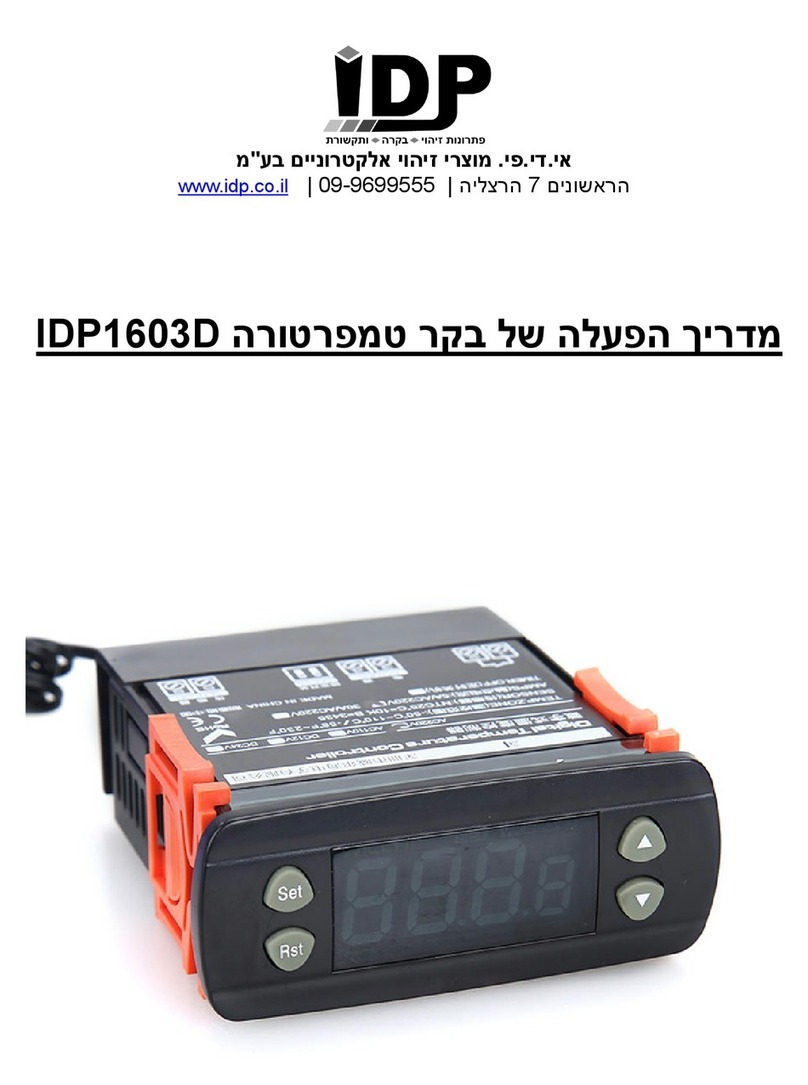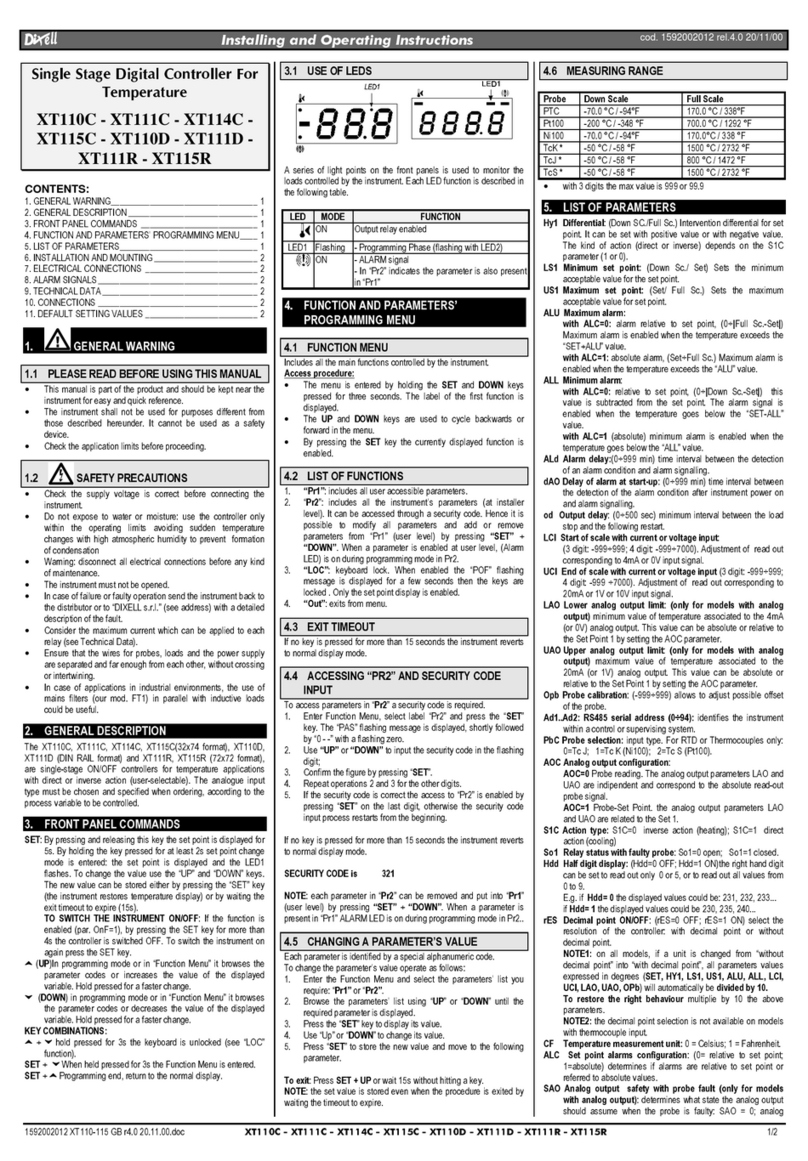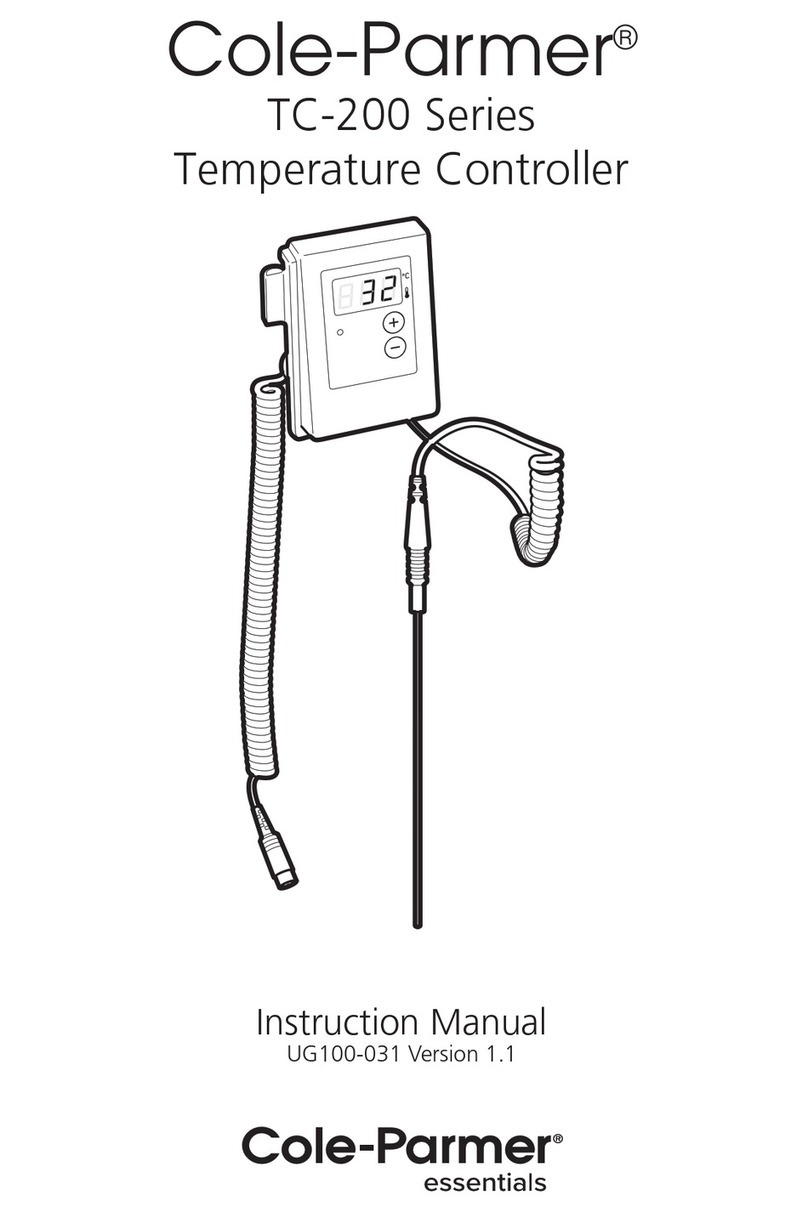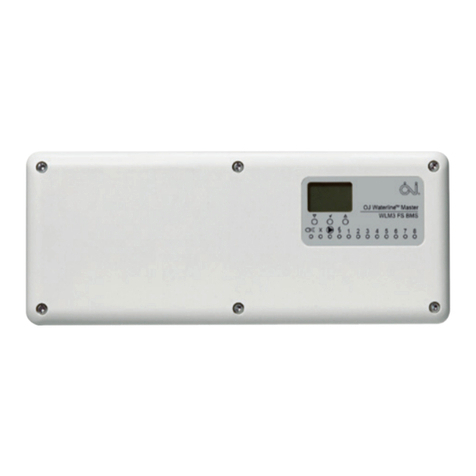Barnant Company 689-0010 User manual

OPERATING MANUAL
TEMPERATURE
CONTROLLER R/S
(ADVANCED MODEL)
689-0010
689-0015
Barnant Company
28W092 Commercial Avenue
Barrington, Illinois U.S.A. 60010-2392
(847) 381-7050
(847) 381-7053 (Fax)
800-637-3739
www.barnant.com
e-mail: bar[email protected]
A-1299-0610
Edition 04
Barnant-cover.p65 10/8/01, 9:42 AM1

EU Declaration of Conformity
Name of Apparatus: Temperature Controller
Model Number: 689-0015
Description of Apparatus: Deluxe Process Temperature
Controller, 15A output.
Barnant Company declares that the above model is in
conformity to the following harmonized standards and directives:
Applicable Applicable Manufacturer’s
Directives Specifications Report Number
73/23/EEC EN61010-1/A2:1995 TR9755
93/68/EEC EN61010-2-010:1995
89/336/EEC EN61326-1/A1:1998 TR9756
92/31/EEC
93/68/EEC
The last two digits of the year in which the current
configuration of the above models were assessed per
the Low Voltage Directive is: 00.
Manufacturer: Barnant Company Division
Cole-Parmer Instrument Company
28W092 Commercial Avenue
Barrington, IL 60010-2392
USA
Tel: 847-381-7050
Manufacturer’s Signature:
James W. Doll Date
Vice President, Engineering
3 October, 2000

i
TABLE OF CONTENTS
Title Page
WARNINGS AND CAUTIONS................................................................1
INTRODUCTION....................................................................................2
APPLICATION DATA ..............................................................................3
DESCRIPTION.......................................................................................3
GENERAL.........................................................................................3
CONTROL PANEL DESCRIPTION ..................................................4
Vacuum Fluorescent Readout......................................................4
UP, DOWN, LEFT Arrows ............................................................4
MENU Key ...................................................................................5
SET Key.......................................................................................5
ALARM Key..................................................................................5
TUNE Key ....................................................................................5
RUN/STOP Key............................................................................5
HEAT, COOL, TUNE LED Annunciators ......................................5
How To Use This Product.............................................................6
INSTALLATION ......................................................................................7
INITIAL HARDWARE SETUP ...........................................................7
SETUP PROCEDURE ......................................................................9
Sensor Types ...............................................................................9
Thermocouple.......................................................................10
Thermistor ............................................................................10
Platinum RTD........................................................................10
Temperature Scale .....................................................................11
Alarm Selections ........................................................................11
Process Alarms.....................................................................13
Process HI ............................................................................13
Process LO ........................................................................... 14
Process HILO ....................................................................... 15
Deviation Alarms...................................................................15
Deviation LO .........................................................................16
Deviation HI ..........................................................................16
Deviation HILO......................................................................17
Deviation Band......................................................................18
Alarm Hysteresis...................................................................19
Audible Alarms ...........................................................................19
Advanced Set-Up .......................................................................20
Sensor Calibrate ........................................................................20
Over Temp Stop ......................................................................... 21
Loop Break Stop ........................................................................ 21

ii
TABLE OF CONTENTS (Continued)
Title Page
Control Action ............................................................................22
Control Mode .............................................................................22
Control Mode On/Off.............................................................23
PID - Proportional Band, Integral and Derivative ..................23
AUTO Tune ........................................................................... 23
Proportional Band ............................................................24
Integral Time ....................................................................24
Derivative Rate ................................................................ 25
Ramp and Soak ....................................................................25
Assured Soak ..................................................................26
Segment Definition ..........................................................26
Control Parameters (CP) .................................................27
Cycle Time ................................................................................. 27
Run Time.................................................................................... 27
Recorder Output ........................................................................28
Serial Baud ................................................................................28
Power Up Control ....................................................................... 28
OPERATION ........................................................................................30
CONTROL MODE...........................................................................30
RAMP AND SOAK MODE .............................................................. 31
TROUBLESHOOTING AND MAINTENANCE .....................................32
TROUBLESHOOTING ....................................................................32
CALIBRATION ................................................................................ 32
MAINTENANCE/CLEANING........................................................... 32
SPECIFICATIONS ...............................................................................33
INPUTS...........................................................................................34
OUTPUTS.......................................................................................35
WARRANTY.........................................................................................36
PRODUCT RETURN............................................................................36
TECHNICAL ASSISTANCE ................................................................. 36
APPENDIX A - SETUP MODE .......................................................... A-1
APPENDIX B - ERROR MESSAGES/CORRECTIVE ACTION ......... B-1
ACCESSORIES ...................................................................BACK PAGE

1
SAFETY PRECAUTIONS
DANGER: There are no user-serviceable parts in this
instrument.Do not remove cover,as high voltages
exist inside the unit.Refer servicing to your dealer.
DANGER: If thermocouples are at a high voltage, this volt-
age will be present at other points inside the unit.
DANGER: For continued fire protection, replace fuse only
with a fuse of the specified current, voltage, and
type. Remove power cord from wall socket before
checking or replacing a fuse. High voltages exist
on fuse terminals.
WARNING: To avoid electric shock, the power cord protective
grounding conductor must be connected to
earth-ground.
WARNING: Install an independent temperature limit control
protection system where a fault condition could
result in fire or other hazard. Failure to install
such a system could result in injury to personnel
or damage to property.
IBM - Reg TM International Business Machines Corp.
Trademarks bearing the ® symbol in this publication are registered in the U.S. and in other countries.

2
INTRODUCTION
This manual provides information for installing and operating the Tempera-
ture Controller R/S (advanced model).
Refer to Figure 1 for a view of the front panel of theTemperature Controller R/
S.Refer to Figures 2 and 3 for a view of the back panels of the 115V or 230
V versions.
FIGURE 1. TEMPERATURE CONTROLLER R/S
FIGURE 2.TEMPERATURE CONTROLLER R/S, BACK PANEL
(115 V MODEL)

3
FIGURE 3.TEMPERATURE CONTROLLER R/S, BACK PANEL
(230 V MODEL)
APPLICATION DATA
Applications for the Temperature Controller R/S include heating and cooling
of solids, liquids, and gases. For all applications, there are certain set-up
operations that should be made carefully to assure optimum and safe perfor-
mance.Thepowerandtypeof heater, thepositioning ofthesensor,theamount
of thermal insulation, the flash point of the heated material and the many
controller set-up menu options are among the many variables to be consid-
ered in setting up the controller.
One of the most important of these considerations is the heater sizing.A heater
thatis too lowpoweredmaynot beableto raise or even maintain the material at
the desired set point.A heater that is too high powered will not maintain precise
temperature control and may be unsafe. Because of the many system vari-
ables, optimum heater sizing must be determined experimentally; however, an
approximation can be made through a few calculations.These calculations are
included in the software program included with the unit.
DESCRIPTION
GENERAL
The Temperature Controller R/S is designed to maintain a constant, pre-set
process temperature. It uses a temperature sensor to detect the temperature
of the process.Using a microprocessor software algorithm, it adjusts a heater
or cooler by varying the output duty cycle.TheTemperature Controller R/S is a
single-loop controller intended for laboratory or industrial applications.The unit
can control loads of up to 15 amperes (A).
TheTemperature Controller R/S is housed in a rectangular metal enclosure,
with plastic bezels on the front and back. All connections are made on the
rear of the unit. The display and keypad are on the front. A bail bar, or tilt
stand, is used to elevate the front display panel for easy viewing and opera-

4
tion.Theunitcanalsobemountedinapanelwith the use of an optional panel
mount kit. A two-line, 16-character, 14-segment vacuum fluorescent display
is used for display of operating, setup, and alarm parameters.
A number of accessories can be used with this deluxe model of theTempera-
tureController, including various types of temperaturesensors,heating units,
cooling units (such as fans or pumps), remote alarms, and recorders.
One of several additional R/S model features (not available in the standard
models) is “Ramp and Soak,” which uses a timed sequence pre-set user
temperature set points.
The unit also has RS-232-C Serial Communications, so that it can be set up
and controlled by a computer. An IBM®-compatible PC (personal computer)
diskisincludedwiththeR/Scontroller,alongwithaseparateoperator'smanual.
It can be used to set up the controller and perform logging and other func-
tions.For advanced users, a serial communications specification is included
on disk for customized programming.
CONTROL PANEL DESCRIPTION
Refer to Figure 4 and the following paragraphs.
Indicator
Lights
Readout Display LEFT Arrow
UP and
DOWN
Arrows
Alarm LED
Function Control Keys
FIGURE 4. FRONT PANEL DISPLAYS
Vacuum Fluorescent Readout
The vacuum fluorescent readout displays operation and setup parameters.
Alarm conditions are also displayed.
UP, DOWN, LEFT Arrows
The UP and DOWN arrow keys will increment or decrement the current val-
ues of displayed (blinking) numerals or enable you to scroll through a list
where multiple-choice parameters are offered. The LEFT arrow key allows

5
you to change default numeric settings by moving the blinking cursor left to
the next most significant digit.When you have reached the most significant
digit (furthest left), the LEFT arrow key will move the flashing cursor back to
the least significant digit (furthest right).
MENU Key
The MENU key allows you to access all of the user-configurable setup pa-
rameters of the Temperature Controller. Pressing the MENU key will scroll
through the parameter options, using the arrow keys to change those param-
eters. Refer to the Setup Procedures section for additional information on
each parameter.
SET Key
The SET key allows you to change the control setpoint (SP), using the arrow
keys. Pressing the SET key again will exit the setpoint mode. In the Ramp
and Soak mode, the SET key will toggle the display between setpoint and run
time remaining. Refer to the Operation section for additional information on
changing the setpoint.
ALARM Key
TheALARMkeyenablesyoutoacknowledgetemperature control alarm con-
ditions and silence the audible alarm.Pressing the ALARM key will erase any
alarm messages on the display and stop the ALARM from flashing. If the
alarm condition is still present, the ALARM LED will remain on until the PV
(process variable) is out of the alarm condition. If manual Reset mode is
selected in setup, the ALARM key will also de-energize the alarm relay.
Refer to Setup Procedures section for additional information on setting the
appropriate alarms.
TUNE Key
The TUNE key will start an AUTO tune cycle. Heat (or cooling) is automati-
cally applied to determine PID values. AUTO tuning must be enabled in the
setup mode for this key to function. Refer to the AUTO Tuning section for
additional information on this setting.
NOTE: When the TUNE key is pressed, the output is turned full on three
times for a period of time and overshoot of the setpoint will occur.
Do not use the AUTO tune feature if this would have an adverse
affect on your process.
RUN/STOP Key
Pressing this key when the Temperature Controller is stopped will start the
control process and activate the load, if required.Pressing this key when the
Temperature Controller is running will cause it to stop.

6
HEAT, COOL, TUNE LED Annunciators
These three indicators will light to indicate Temperature Controller functions.
The green HEAT light will turn on when power is being applied to the heater
output.The green COOL light will turn on when theTemperature Controller is in
the cooling mode and power is applied to the cooler output.The yellow TUNE
light will turn on when the Temperature Controller is in the AUTO tuning mode.
How to Use this Product
Here is a summary of the steps required to setup and operate the Tempera-
ture Controller R/S.
1. Install the unit.
Setup your process.
Plug the Controller power cord to an AC outlet, turn unit on.
Plug the heater (or cooler) into the Controller rear panel and install in
your process.
Connect a sensor to the rear panel (thermocouple, RTD or thermistor)
and install in your process.
Optional installation connections:
Connect a recorder to the recorder contacts on the rear panel.
Connectanexternalalarmtothealarmoutputconnectionontherearpanel.
Connect a serial cable between the Controller RS232 connector and a
PC and follow the instructions for setup in the separate PC program op-
erator manual.
2. Setup the operating parameters. Press MENU and follow the interactive
setup selections. If your setup is the same as the factory set defaults,
this step is not necessary.However, each of the setup options should be
checked for desired or proper setting.
Set sensor type that was connected.
Select temperature scale.
Set alarms, if desired.
Calibrate system, if better accuracy is desired.
Set safety stops (over temperature and loop break).
Select control action and mode desired (PID, on/off or Ramp/Soak).
Setup recorder output temperatures, if a recorder is connected.
Set baud rate for serial connection, if a PC is connected.
3. Set the run temperature and begin controlling.
Press the SET key and enter the desired setpoint temperature.
Press TUNE if autotune is selected in setup and you want to automati-
cally determine the PID settings.
Press the RUN/STOP key to begin temperature control.
The setpoint (SP) temperature and the actual temperature (or process
variable, PV) are displayed.
Press ALARM to acknowledge an alarm condition.

7
INSTALLATION
INITIAL HARDWARE SETUP
1. Remove controller from packaging.Keep all packing material until proper
operation has been verified.
2. Use the "bail" bar (or tilt-stand) at the bottom of the unit to adjust position
for easy viewing of front panel.
Caution: To avoid electric shock, the power cord pro-
tective grounding conductor must be con-
nected to earth-ground.
Caution: Install an independent temperature limit con-
trol protection system where a fault condition
could result in fire or other hazard. Failure to
install such a system could result in injury to
personnel or damage to property.
3. Plug the unit in to a correctly rated AC outlet and turn on the power using
the ON/OFF switch on the back panel. Refer to Figure 5.
FIGURE 5. 115 V BACK PANEL
3 Wire RTD
Probe Jack
Thermistor
Probe Jack
Heater/Cooler
Output Fuse ON/OFF
Switch
Main
Power
Fuse
Heater Cord
Cable Connection
Recorder Output
Isolated 4-20 mA
RS-232-C Serial
Connector
Mini-ANSI Thermocouple
Jack (500 ohm Max
Load Resistance)
115 V

8
Line Cord
Connection
Heater Cord
Cable Connection
Recorder Output
Isolated 4-20 mA
RS-232C Serial
Connector
Mini-ANSI Thermocouple
Jack (500 ohm Max
Load Resistance)
Heater/Cooler
Output Fuse
Thermistor
Probe Jack
3 Wire RTD
Probe Jack
ON/OFF
Switch
Main
Power
Fuse
230 V
FIGURE 5. 230 V BACK PANEL
4. Connect one of the three types of sensors to the unit (refer to Accesso-
ries section for a listing of compatible probes).
5. Connect the heater or cooler (maximum of 15 A) to the unit.
6. Install the PC (personal computer) cable to the RS-232-C serial commu-
nications terminal, if desired. Refer to your PC hardware guide for PC
connections.
7. The following charts show the required connections for interfacing to an
IBM-compatible computer with either a 9-pin or 25-pin plug.The cables
listed in the Accessories section are properly wired for use.
Temperature
Controller Computer Computer
DB-9 DB-9 DB-25
Pin 2 Pin 3 Pin 2
Pin 3 Pin 2 Pin 3
Pin 5 Pin 5 Pin 7
RS-232-C Connection Chart
NOTE: The serial data format is full duplex, 1 start bit, 8 data bits, no
parity, and 1 stop bit.The baud rate is user-selected.

9
8. Recorder output and alarm output devices may be installed on the tem-
perature controller (refer to Figure 5). The 4/20mA recorder output is
designed for a left positive (+) and a right negative (-) connection.Alarm
output is designed for a left–NO (normally open), center–COM (com-
mon), and right–NC (normally closed) connector.
SETUP PROCEDURE
NOTES: a. At any time during the setup procedure, you may return to
the previous screen by pressing and holding down the LEFT
arrow key and then pressing the MENU key.
b. For experienced operators, a flow chart may be used for set-
up. Refer to Appendix A.
c. The setup mode can only be entered when the Temperature
Controller is stopped.
1. Set the ON/OFF switch on the rear panel to ON.The LEDs will light and
all segments will light temporarily as a check of the display.
2. After the diagnostics are complete, the Temperature Controller will dis-
play the unit identification screen (refer to Figure 6).
TEMPERATURE
CONTROLLER
FIGURE 6. UNIT IDENTIFICATION SCREEN
This screen will be displayed for a few seconds.The unit will automati-
cally progress to the RUN screen.
3. Press MENU once to begin the setup process.
Sensor Types
1. To select a sensor type, press the DOWN arrow key.The following
screen will appear, with the default, or last selected, sensor indi-
cated (refer to Figure 7).
SENSOR TYPE
THERMOCOUPLE
FIGURE 7. SENSOR TYPE SELECTION SCREEN

10
2. Press the DOWNarrowkeytoselectoneofthethreesensortypes,
which are described as follows:
Thermocouple
1. To select a thermocouple type, press the MENU key (refer to Figure 8).
2. The screen will display the last thermocouple selected. To chose an-
other thermocouple type, press the DOWN arrow key to move forward
or, if passing a desired selection, the UP arrow key to move backward.
Thermocouple selections include: K, J, E, B, T, S, R, and N.
3. Select the thermocouple type by pressing the MENU key. To ensure
proper operation, be sure that the correct thermocouple type is con-
nected at the thermocouple jack before running the program.
THERMOCOUPLE
TYPE J
FIGURE 8.THERMOCOUPLE SELECTION SCREEN
Thermistor
1. The second sensor type available is the thermistor.Press the MENU key
at the SENSOR TYPE - THERMISTOR screen to display the following
screen (refer to Figure 9).
2. Use the UP or DOWN arrow key to chose either YSI 400 or YSI 700
thermistors.
3. After selecting the correct thermistor, press the MENU key.
THERMISTOR
YSI 400
FIGURE 9.THERMISTOR SELECTION SCREEN

11
Platinum RTD
1. The Platinum RTD is the third sensor type that can be selected. Press
the MENU key at the SENSOR TYPE - PLATINUM RTD screen and the
following screen will appear (refer to Figure 10).
2. SelecteitherAlpha .003850orAlpha.003916.SelectanAlphaof0.003850
(default setting) for all probes listed in the Accessories section.
3. After selecting the platinum RTD type, press the MENU key to advance
to Temperature Scale selection.
100 OHM RTD
ALPHA .003850
FIGURE 10. PLATINUM RTD SELECTION SCREEN
Temperature Scale
1. After pressing the MENU key in the SENSOR-TYPE screen, the
program will progress to theTemperature Scale selection.TheTem-
perature scale selection has five temperature scales from which to
choose: Celsius(°C),Fahrenheit(°F), Reaumur(°R'), Rankine (°R),
or Kelvin (K). Refer to Figure 11.
2. Press theDOWNarrowkeyto switchtoa desired temperaturescale.
Press the MENU key to select the appropriate scale.
TEMP SCALE
FAHRENHEIT °F
FIGURE 11.TEMPERATURE SCALE SELECTION SCREEN

12
Alarm Selections
1. Alarms will activate only when the Temperature Controller is in the RUN
mode. When an alarm occurs, the alarm relay will energize, the alarm
LED will flash, the audible alarm will sound intermittently and the display
will flash the type of alarm.There are three possible alarm mode selec-
tions: MANUAL RESET, AUTO RESET, or OFF. Refer to Figure 12.
2. If you select ALARM SETPOINTS - OFF, no process or deviation alarms
will actuate.Both AUTO RESET and MANUAL RESET will result in alarms
actuating. If you select AUTO RESET, the relay will automatically shut off
when the PV temperature falls out of the alarm setpoint temperature. For
MANUAL RESET, the alarm relay is turned off when the ALARM key is
pressed. The alarm LED remains on until the alarm condition clears. For
both AUTO and MANUAL, the flashing message and the audible alarm are
turned off.
3. The first Alarm screen will display ALARM SETPOINTS - MANUAL RE-
SET. Refer to Figure 13.
ALARM SETPOINTS
MANUAL RESET
FIGURE 13. ALARM SETPOINTS MANUAL RESET SCREEN
4. To go to the Auto Reset Screen, press the DOWN arrow key. Refer to
Figure 14.
ALARM SETPOINTS
[SELECTIONS]
FIGURE 12. ALARM SETPOINTS SELECTION SCREEN
ALARM SETPOINTS
AUTO RESET
FIGURE 14. ALARM SETPOINTS AUTO RESET SCREEN

13
5. To select an automatic alarm reset, press the MENU key when the Auto
Reset screen is blinking.
6. To go to the Alarms Off Screen, press the DOWN arrow key. Refer to
Figure 15. If selected, refer to Alarms Auto Reset procedure, below.
ALARM SETPOINTS
OFF
FIGURE 15. ALARM SETPOINT OFF SCREEN
7. To select alarms off, press the MENU key when the ALARMS - OFF
screen is blinking.
8. After alarm selection, press the MENU key to move on to Alarm Hyster-
esis.After setting Alarm Hysteresis, press the MENU key again to move
on to the Audible Alarm screen.
Process Alarms
Process alarms are absolute values.These values remain the same no mat-
ter what the setpoint temperature is set to. For example: if the operator sets
an alarm to trigger at 60 degrees Celsius and the SP (setpoint) temperature
is set at 55 degrees Celsius, the alarm will trigger at 60 degrees.If the opera-
tor resets the SP temperature to 57 degrees, then the process alarm value
will stay at the already set 60 degrees.
There are three types of process alarms: PROCESS HI, PROCESS LO, and
PROCESS HILO. Refer to the following paragraphs for more information.
Process HI
1. Process HI is a fixed value and will not change if the SP temperature
value is changed. It activates the alarm when the PV temperature ex-
ceeds the set alarm temperature.Refer to Figure 16.If the Control Action
is set to COOL and the PV temperature exceeds the alarm temperature
when the RUN key is pressed, the alarm will not be activated. The PV
temperature must first fall below the alarm temperature before the high
alarm is enabled.This allows for normal system startup without activat-
ing the alarm.
ALARM MODE
PROCESS - HI
FIGURE 16. PROCESS HI SCREEN

14
2. Select the PROCESS - HI screen by pressing the MENU key.The follow-
ing screen will appear (refer to Figure 17). Set the Process HI tempera-
ture by using the arrow keys.
PROCESS ALARM
HI XXXXX °F
FIGURE 17. PROCESS HI SETTINGS SCREEN
Process LO
1. Process LO is a fixed value and will not change if the SP temperature
value is changed.It activates the alarm when the PV temperature drops
below the alarm temperature.Refer to Figure 18.If the Control Action is
set to HEAT and the PV temperature is below the alarm temperature
when the RUN key is pressed, the alarm will not be activated. The PV
temperature must first rise above the alarm setpoint before the low alarm
is enabled.This allows for normal system startup without activating the
alarm.
ALARM MODE
PROCESS - LO
FIGURE 18. PROCESS LO SCREEN
2.Select the PROCESS - LO screen by pressing the MENU key. The fol-
lowing screen will appear (refer to Figure 19). Set the Process LO tem-
perature by using the arrow keys.
PROCESS ALARM
LO 000XX °F
FIGURE 19. PROCESS LO SETTINGS SCREEN

15
Process HILO
1. Process HILO is afixedvalue(afixedhigh and a fixedlowalarm setpoint)
and will not change if the SP temperature value is changed.The purpose
for process HILO is to set the fixed HI and LO value at which to trigger
the alarm relay. Refer to Figure 20.Refer to the Process HI and Process
LO sections for detailed descriptions of the operation of each alarm
setpoint.
ALARM MODE
PROCESS HILO
FIGURE 20. PROCESS HILO SCREEN
2. Select PROCESS-HILO bypressing the MENUkey.Thefollowingscreen
will appear (refer to Figure 21).Set the alarm temperatures by using the
arrow keys.Once the first alarm value is set, press the LEFT arrow key to
adjust for the other alarm variable.
PROCESS ALARM °F
HI XXXX.X LO XXXX.X
FIGURE 21. PROCESS HILO SETTINGS SCREEN
Deviation Alarms
Deviation alarms are offset values relative to the setpoint (SP). The values
change with the SP temperature setting.For example:if an operator sets the
deviation HI alarm to 10 degrees Fahrenheit and the SP temperature is at 50
degrees Fahrenheit, the alarm will trigger when the PV reaches 60 degrees
Fahrenheit. If the operator then changes the previously set SP temperature
to 55 degrees Fahrenheit, then the alarm will trigger at 65 degrees Fahren-
heit.The 10-degree Fahrenheit difference stays the same.
There are four possible deviation alarms settings: DEVIATION LO, DEVIA-
TION HI, DEVIATION HILO, and DEVIATION BAND. Refer to the following
paragraphs.

16
Deviation LO
Deviation LO adjusts the alarm value as the SP temperature value is adjusted.
Whatever value deviation LO is set at, it will remain the same until changed.
Refer to Figure 22.
ALARM MODE
DEVIATION LO
FIGURE 22. DEVIATION LO SCREEN
For example: if the Deviation LO value is set for 10 degrees Fahrenheit and
the SP temperature is set for 50 degrees Fahrenheit, the alarm will trigger at
40degreesFahrenheit.If the SP temperaturevalueischangedto45 degrees
Fahrenheit, the Deviation LO will trigger the alarm at 35 degrees Fahrenheit.
If the Control Action is set to HEAT and the alarm condition exists when the
RUN key is pressed, the alarm will not be activated. The PV temperature
must first rise above the alarm setpoint before the alarm is enabled. This
allows for normal system startup without activating the alarm.
Select the DEVIATION - LO screen by pressing the MENU key.The following
screen will appear (refer to Figure 23). Move the cursor to the left using the
LEFT arrow key. When the setting is correct, press the MENU key to enter
that setting and to move the program to the alarm hysteresis screen.
DEVIATION ALARM
LO XXXXX °F
FIGURE 23. DEVIATION LO SETTINGS SCREEN
Deviation HI
Deviation HI will adjust the alarm value as the SP temperature value is ad-
justed. Whatever value Deviation HI is set at, it will remain the same until
changed. Refer to Figure 24.
ALARM MODE
DEVIATION HI
FIGURE 24. DEVIATION HI SCREEN
This manual suits for next models
1
Table of contents
Popular Temperature Controllers manuals by other brands

Bühler technologies
Bühler technologies Nivotemp NT 67-XP Brief instructions
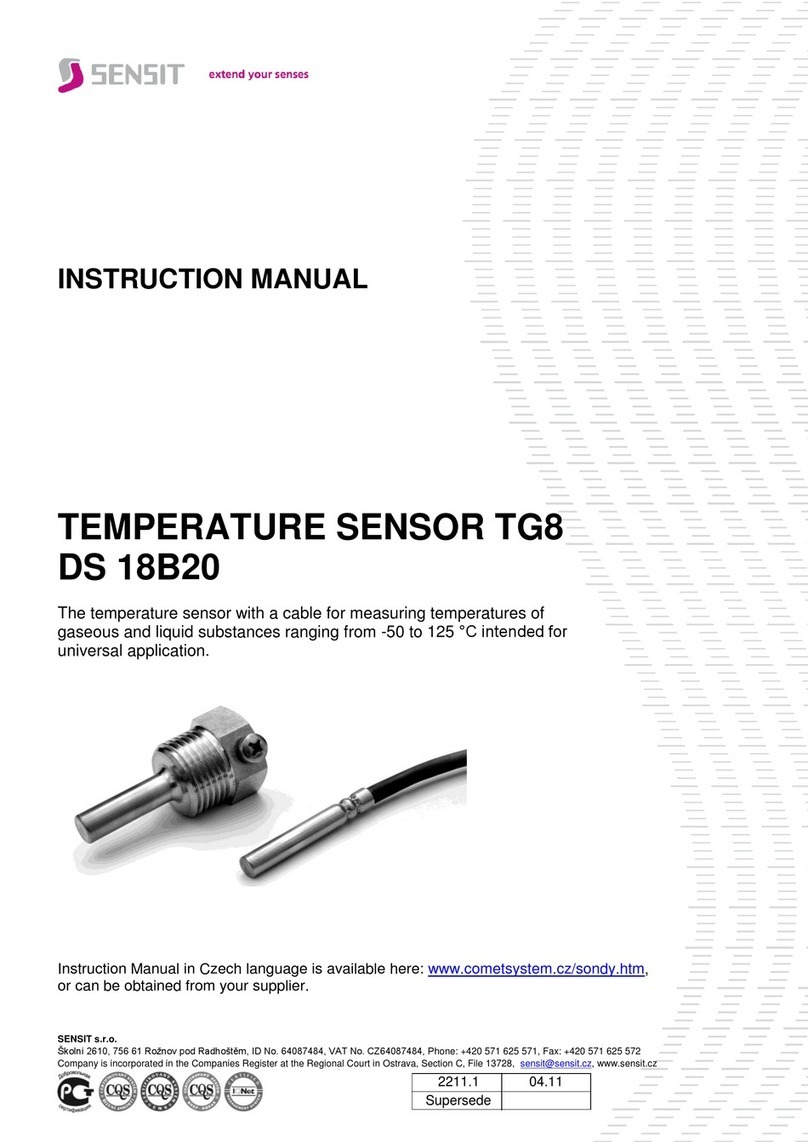
Sensit
Sensit TG8 instruction manual
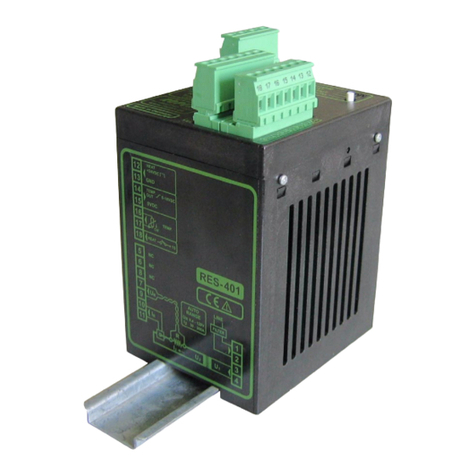
Ropex
Ropex RESISTRON RES-401 operating instructions
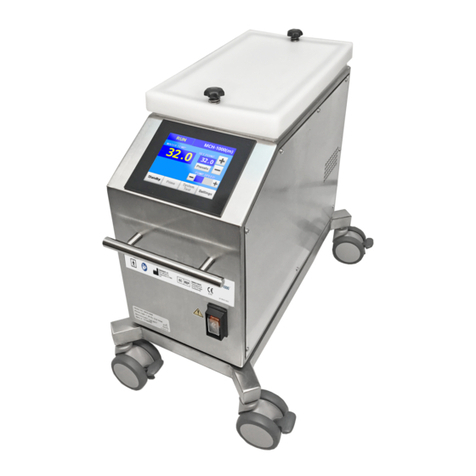
CardioQuip
CardioQuip MCH-1000 Operators & service manual
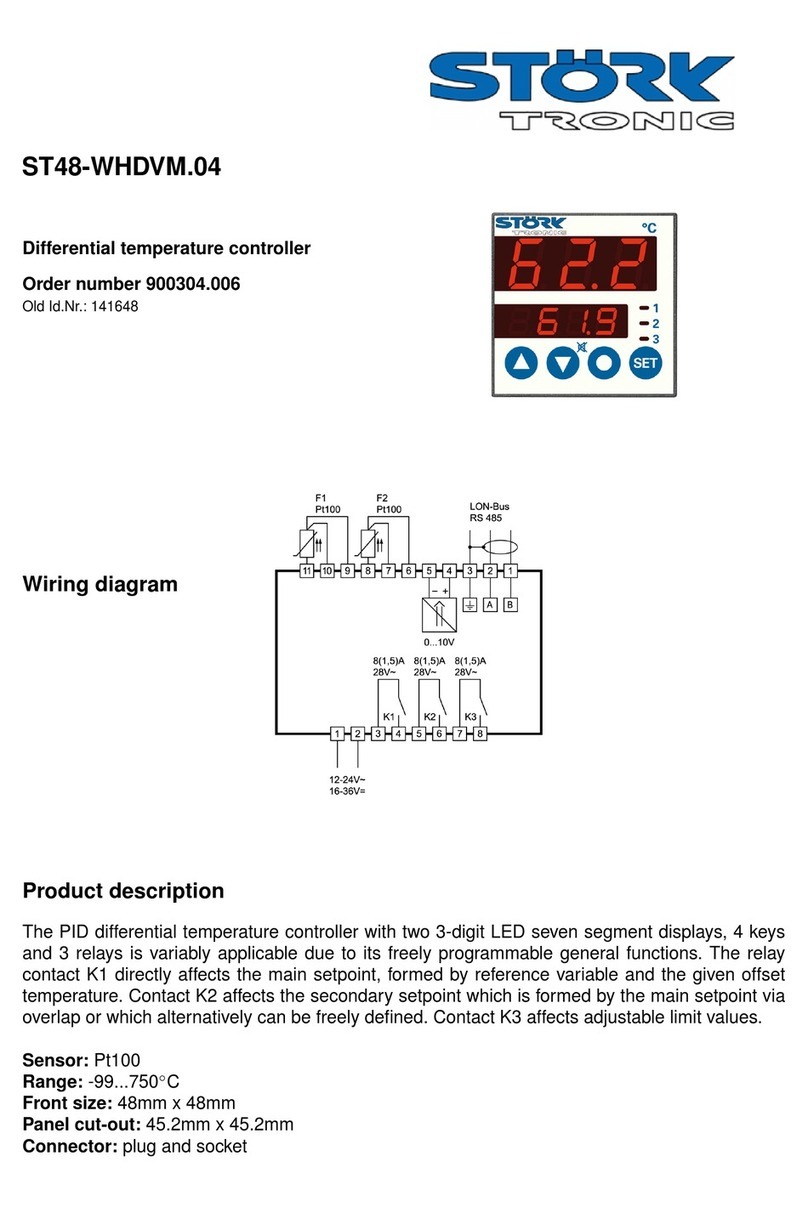
STORK TRONIC
STORK TRONIC ST48-WHDVM.04 manual
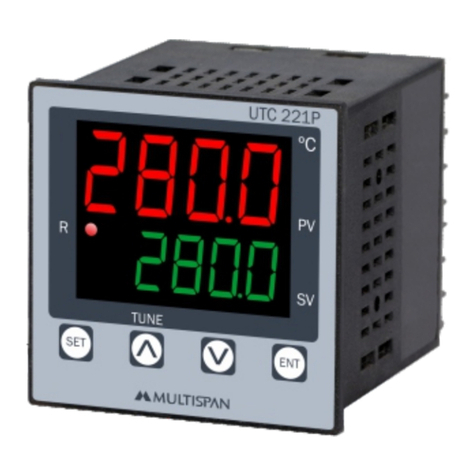
MULTISPAN
MULTISPAN UTC-221P quick guide
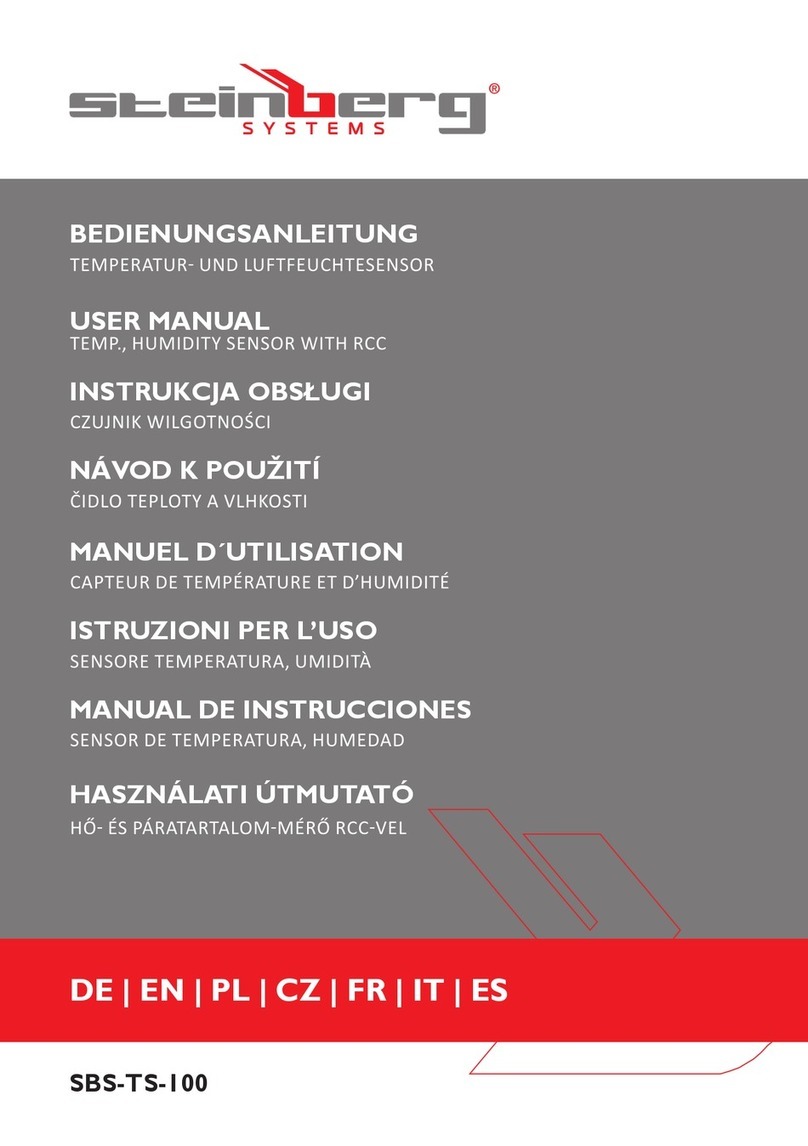
Steinberg Systems
Steinberg Systems SBS-TS-100 user manual

Adeunis RF
Adeunis RF ARF8054AA user guide
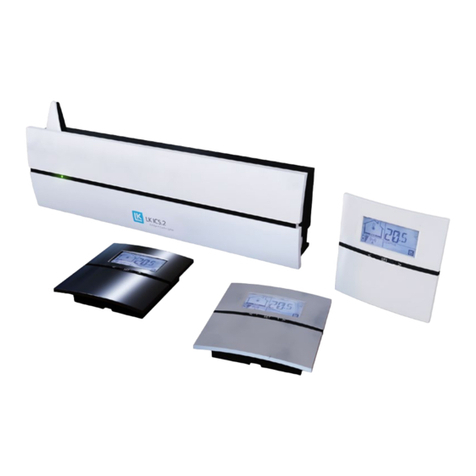
LK Systems
LK Systems ICS.2 Assembly instructions
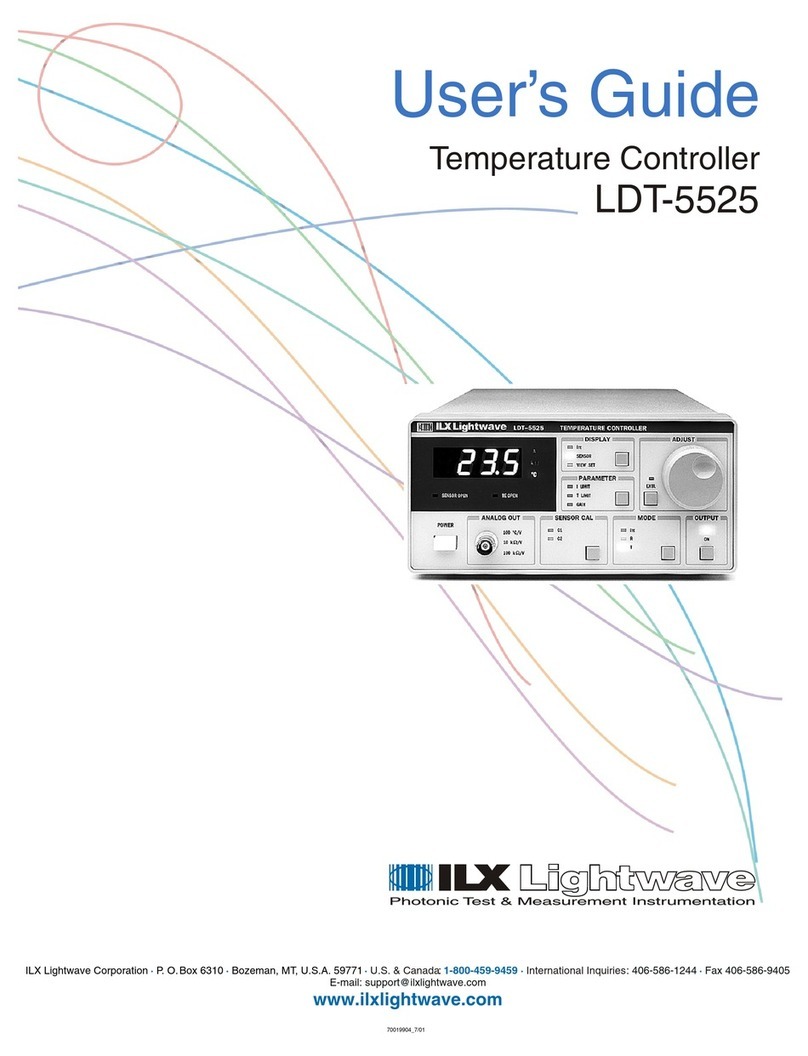
ILX Lightwave
ILX Lightwave LDT-5525 user guide

SRS Labs
SRS Labs CTC100 user manual
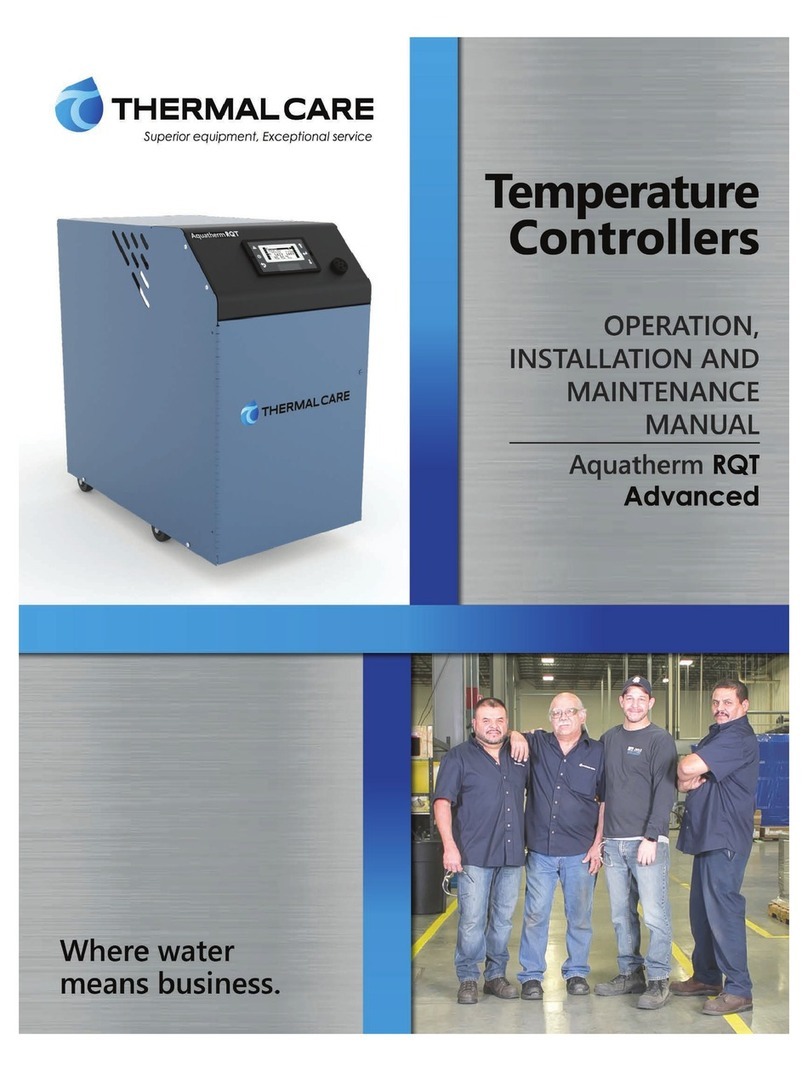
Thermal Care
Thermal Care Aquatherm RQT Advanced Operation, installation, and maintenance manual
